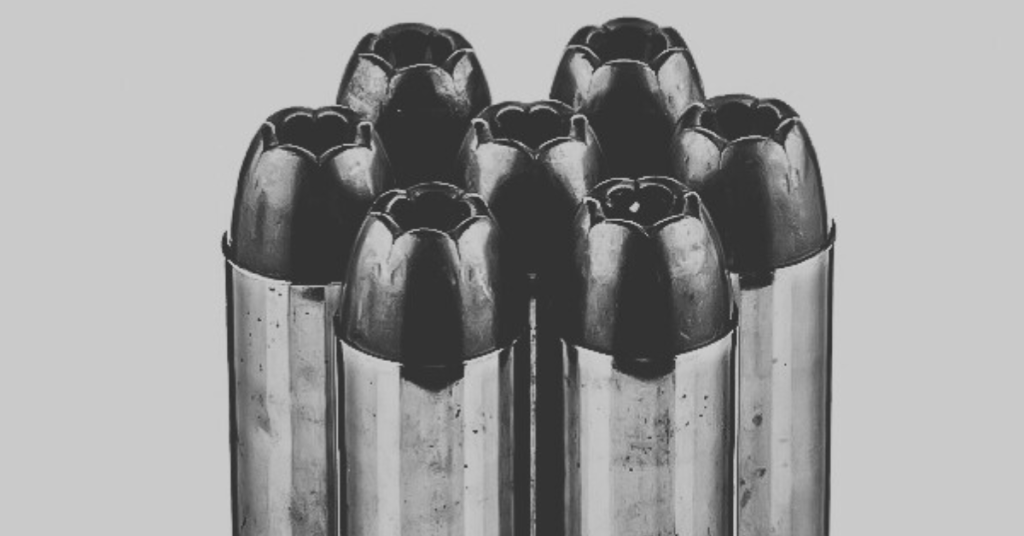Glock introduced .45 Glock Automatic Pistol (GAP) ammunition in 2003. It was the first cartridge manufactured by the Austrian firearms manufacturer.
The ammo is a rimless, straight-walled round that shares the same bullet diameter of the .45 Automatic Colt Pistol (ACP). The diameter is .451 inch.
The .45 GAP is housed in a .755-inch casing, the same length as a 9mm shell). The cartridge’s overall length is 1.070 inches.
The ammo is made with a big bore bullet and uses a small pistol primer. Its maximum pressure is 23,000 pounds psi. It is ideal for self-defense and concealed carry.
The round is suitable for use by civilians, military and law enforcement. It is efficient, accurate, and reliable. Glock has supplied United States law enforcement with more handguns in the last twenty years than any other weapons manufacturer.
Development of the .45 GAP
Glock aimed to design a .45 cartridge for a compact handgun that didn’t have an oversized grip. The design would allow the weapon to be used for concealed carry.
In 2003, Glock introduced the Glock 37. They collaborated with ammunition designer Ernest Durham, an engineer with CCI/Speer.
Glock told Speer what it needed in new ammunition. They wanted a .45 caliber bullet housed in a case no longer than the one used for a 9mm Parabellum or .40 S&W.
They also requested a cartridge that could easily fit inside a grip similar to their Model 17 or 22 pistols. The size would ensure that the gun could be used by most shooters, regardless of the size of the user’s hand.
Speer delivered the cartridges. The finished product was created using bullets ranging from 165-grain to 230-grain. The .45 GAP ammo’s muzzle energy averages 400 to 500 foot-pounds (ft-lbs).
The Popularity of the .45 GAP
The public quickly embraced the .45 GAP. As a result, several firearms manufacturers made pistols to house the new ammo. The trend died down and eventually Glock and Bond Arms became the only companies to continue production.
Currently, Glock offers several pistols chambered in .45 GAP: Model 37 (full-size), 38 (compact), and 39 (sub-compact).
Some shooters falsely claim that the .45 ACP and .45 GAP are interchangeable. The extractor grooves are cut differently which makes the main difference. Additionally, the .45 GAP uses a small pistol primer whereas the .45 ACP uses a large pistol primer.
Law Enforcement
Glock’s biggest success with the .45 GAP has been with the law enforcement community. Several state law enforcement agencies use the Glock 37 with .45 GAP ammo as standard issue. The ammo has similar fire power and performance compared to the .45 ACP yet is more compact.
Many law enforcement agencies have switched from .45-caliber weapons in favor of guns chambered in 9x19mm and .40 S&W.
Despite the trend, three state law enforcement agencies have chosen the .45 GAP as a replacement for their standard issue 9mm Parabellum (New York) or .40 S&W service weapons (Florida and South Carolina).
Smaller law enforcement agencies have also chosen to use the Glock 37 and .45 GAP. They include the Burden, Kansas Police Department, Greenville, North Carolina Police Department, and the Berkeley, Missouri Police Department.
The Georgia State Patrol previously carried the Glock Model 37. It has replaced it with the fourth generation 9mm Glock 17. The South Carolina Highway Patrol also abandoned the Glock 37 in favor of the Glock 17 “M” also chambered in 9mm.
The Pennsylvania State Police used the Glock 37 from 2007-2013. Lack of ammunition caused the agency to adopt the fourth generation Glock 21 chambered in .45 ACP. The police experienced recall issues and switched to the SIG-Sauer P227 in .45 ACP.
Types of .45 GAP Ammo
Several ammunition manufacturers produce .45 GAP ammunition, but it’s not a popular round. Most shooters looking for bulk ammunition choose from full metal jacket (FMJ), total metal jacket (TMJ), or jacketed hollow point (JHP) rounds.
- Full Metal Jacket (FMJ) ammo is a lead bullet enclosed in a metal, typically copper, casing. The casing helps the projectile maintain its shape from firing to impact at the target site.
FMJ rounds are typically used for plinking and target shooting. They can also be used for self-defense purposes. - Total Metal Jacket (TMJ) ammo is like FMJ in that it uses a lead bullet sheathed in a harder metal. The lead bullet is exposed within the round’s casing, unlike the FMJ. TMJ bullets feature a projectile is encased in copper.
The shooter’s exposure to lead is limited due to the cooper casing. Some indoor shooting ranges in the U.S. require this configuration. - Jacketed Hollow Point (JHP) ammo also uses a lead bullet encased in copper, but this bullet has a hollow point in its center. The hollow point allows for greater expansion upon impact.
The expansion creates a larger entrance wound while reducing the risk of over-penetration.

